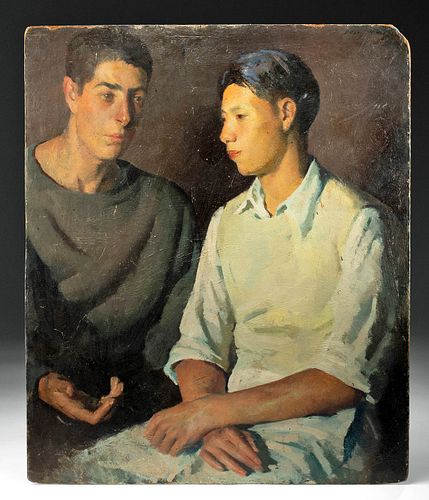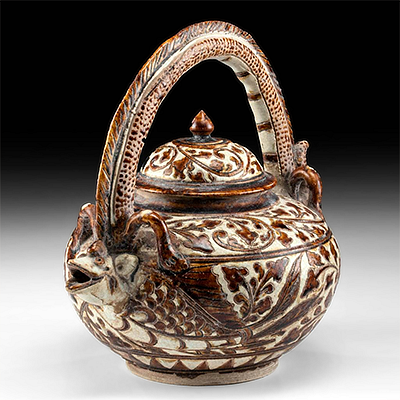Henry Hensche Painting - Double Portrait, 1930s
Lot 158
About Seller
Artemis Gallery
686 S Taylor Ave, Ste 106
Louisville, CO 80027
United States
Selling antiquities, ancient and ethnographic art online since 1993, Artemis Gallery specializes in Classical Antiquities (Egyptian, Greek, Roman, Near Eastern), Asian, Pre-Columbian, African / Tribal / Oceanographic art. Our extensive inventory includes pottery, stone, metal, wood, glass and textil...Read more
Categories
Estimate:
$3,000 - $5,000
Absentee vs Live bid
Two ways to bid:
- Leave a max absentee bid and the platform will bid on your behalf up to your maximum bid during the live auction.
- Bid live during the auction and your bids will be submitted real-time to the auctioneer.
Bid Increments
| Price | Bid Increment |
|---|---|
| $0 | $25 |
| $300 | $50 |
| $1,000 | $100 |
| $2,000 | $250 |
| $5,000 | $500 |
| $10,000 | $1,000 |
| $20,000 | $2,500 |
| $50,000 | $5,000 |
| $100,000 | $10,000 |
| $200,000 | $20,000 |
About Auction
By Artemis Gallery
Jul 1, 2021
Set Reminder
2021-07-01 10:00:00
2021-07-01 10:00:00
America/New_York
Bidsquare
Bidsquare : Antiquities | Asian | Ethnographic Art
https://www.bidsquare.com/auctions/artemis-gallery/antiquities-asian-ethnographic-art-7148
Featuring classical antiquities, ancient and ethnographic art from cultures encompassing the globe. Egyptian, Greek, Roman, Near Eastern, Asian, Pre-Columbian, Native American, African / Tribal, Oceanic, Spanish Colonial, Russian, Fossils, Fine Art, more! All legally acquired, legal to sell. Artemis Gallery info@artemisgallery.com
Featuring classical antiquities, ancient and ethnographic art from cultures encompassing the globe. Egyptian, Greek, Roman, Near Eastern, Asian, Pre-Columbian, Native American, African / Tribal, Oceanic, Spanish Colonial, Russian, Fossils, Fine Art, more! All legally acquired, legal to sell. Artemis Gallery info@artemisgallery.com
- Lot Description
Henry Hensche (German American, 1899-1992). Double portrait. Oil on canvas board, ca. 1930s. Signed "Henry Hensche" in black on the upper right. A wonderful composition by Henry Hensche featuring a double portrait of a seated young man of Asian descent dressed in a lemon yellow vest over a white shirt with rolled up sleeves, and a young Caucasian male who bears a striking resemblance to Henry Hensche and is dressed in charcoal grey. The man in the yellow vest sits with his body turned toward the man dressed in grey, his hands crossed upon his lap and his head in profile. The other man, who may represent Hensche, is presented bust-length with his handsome visage addressing the other sitter and engaging with a hand gesture. Size: 29.875" L x 25" W (75.9 cm x 63.5 cm)
"As a painter and teacher of consummate skill, Hensche is considered by many in the art world to be an unparalleled colorist - a painter justly deserving the artistic lineage that extends back just two generations to the seminal American impressionist, William Merritt Chase. He has been called an iconoclast, a pioneer, and the late Grand Central Art Galleries of New York named him, 'L'Enfant Terrible de L'Academie'. A teacher for over 60 years, Hensche instilled in his students a profound appreciation for the beauty of nature's light and color. Between 1922 and 1930 Hensche won the Pulitzer Traveling Prize from Columbia University and the Halgarten Award from the National Academy of Design. He has exhibited at The Art Institute of Chicago, The Corcoran, The Pennsylvania Academy of Fine Arts, and has had many other one-man-shows. He is listed in Who's Who in American Art. Some of his students who have gone on to become nationally successful painters are William Draper, Franz Kline, and Nelson Shanks." (Henry Hensche Foundation website)
This painting comes to us from the Estate of William F. Draper, an American artist who studied with Henry Hensche in Cape Cod. Hensche studied at the Art Students League in New York City. By the summer of 1919, he arrived in Provincetown and studied with Charles Webster Hawthorne (American, 1872-1930) at the Cape Cod School of Art (est. 1899). Hensche admired Hawthorne's "color note" approach to painting and even saw this as an advance beyond Claude Monet and William Merritt Chase. "Monet was a painter; he didn't teach. What was needed was a way to put his principles into some kind of teachable form...in the America of that day, William Merritt Chase was the most famous teacher. He taught Hawthorne - and almost everyone else. But, he never really came to grips with the Impressionists' idea. His paintings were really done in tone - in black and white - with Impressionists colors added. He never developed a clear method."
Provenance: The William F. Draper Collection, New York City, USA, acquired via descent from the late William Franklin Draper (1912-2003)
All items legal to buy/sell under U.S. Statute covering cultural patrimony Code 2600, CHAPTER 14, and are guaranteed to be as described or your money back.
A Certificate of Authenticity will accompany all winning bids.
We ship worldwide and handle all shipping in-house for your convenience.
#153746Areas of surface wear with minor scuffs and abrasions. Wear/loss to corners as shown. Signed "Henry Hensche" in black on upper right. There is also a landscape painting on the verso. Draper Estate stamp on verso.Condition
- Shipping Info
-
All shipping is handled in-house for your convenience. Your invoice from Artemis Gallery will include shipping calculation instructions. If in doubt, please inquire BEFORE bidding for estimated shipping costs for individual items.
-
- Buyer's Premium



 EUR
EUR CAD
CAD AUD
AUD GBP
GBP MXN
MXN HKD
HKD CNY
CNY MYR
MYR SEK
SEK SGD
SGD CHF
CHF THB
THB














